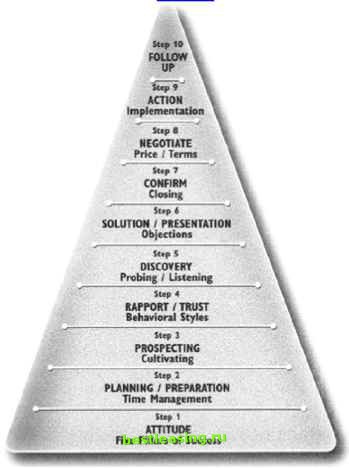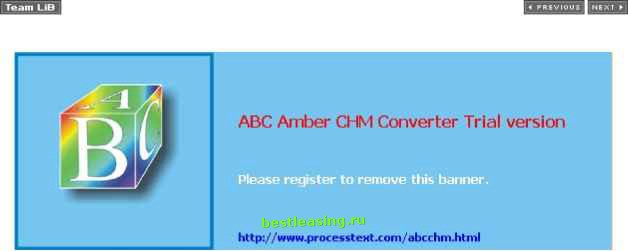

 |
 |

|
Промышленный лизинг
Методички
Ten Steps Guided by the principle of the sequential learning process, I have developed the Sequential Model of Professional Selling. Working with customers coupled with feedback acquired by training thousands of sales professionals has enabled me to create a model that is simple, yet reflects all of the ingredients required to make a sale (Figure 1.1).  Figure 1.1: The Sequential Model of Professional Selling The Sequential Model visually presents the ten steps of selling and helps clarify the selling sequence. This is what selling looks like. Each step of the model, when learned and applied, endows you with the capacity to advance to the next step. Each step is related to all the others. The final outcome of the sales interview is determined not by your ability to perform one step, but by your ability to perform all steps throughout the execution of the sale. Once again, selling today requires a sophisticated set of skills. Websters Dictionary defines model as: 1) a standard or example for imitation or comparison; 2) a pattern on which something not yet produced will be based. That is exactly my objective: to provide an example, a pattern to be imitated throughout the sales call. The Sequential Model provides the minimum acceptable standards on which to base your performance. Anything less compromises your success. The model gives you the confidence to effectively navigate through the entire sales call. It is a guideline, a blueprint that can be tailored to your specific selling arena. Dont view the model as a rigid, ten-step strategic engagement with your customer. Each sales call must be situational, guided by the spirit of the model. It becomes a seamless interaction with the customer-a very fluid dialogue. Beginning with Step #1, each step of the model must be successfully completed prior to advancing to the next step. When I say successfully completed, I am referring to success as defined by your customer. To earn the right to advance the sale, the customer must be satisfied with your performance at every step. He or she is the ultimate referee of your performance. Every successfully completed step sets up the next one, steadily moving the potential customer toward a buying decision without pressure. Consider your progress as a series of graduations-complete the required curriculum of each step, graduating to the next one. Bypass a step or leap-frog a step and you seriously jeopardize the end result, which is win-win. Sorry, no shortcuts. No missing pieces allowed.  What Is a Customer? Six Types To enhance our understanding and comprehension of customer, I offer Websters definition as a logical starting point: 1) a person who buys, especially on a regular basis; 2) a person with whom one must deal. At the end of the day customers are the sole provider of every business-the revenue stream that pays for everything else. You can have the best product, the best accountant, the best management, and so on, but you have nothing without a revenue stream. And the revenue stream is the direct contribution of sales, period. Nothing happens until something is sold. Lets look at the six types of customers. 1. External Customer. These are the people and organizations who have a need for your product or service. They purchase your stuff in exchange for money. They have a budget and will give you some of it in exchange for a solution that meets their needs and expectations. Given that, I affectionately refer to external customers as ones with the bag of money. They have the financial autonomy to decide where and how they will spend their budget-the bag of money. The question is, who gets the bag of money, you or your competitor? Who has earned the confidence and trust of the customer? You and your competitor are vying for a piece of their budget-the best solution wins. Know this: Customers vote with their money and complain with their feet. 2. Allies. These are the users of your product or service, not the ultimate decision maker. These customers usually dont have a bag of money but they play a vital role in your success. They do not make the final decision but they may have tremendous impact on the outcome. They are often closely connected to the bag of money and positioning them as an ally to your cause is critical for your success. You must earn their trust and confidence if you expect them to support you at the bag of money level. A caution about allies: They have veto power, the authority to say no. They can give you a hundred nos but cant give you the one yes needed to close the deal. I have seen countless selling hours wasted on allies with the hope of closing the deal. However, allies can be a tremendous wealth of information. Pick their brains and learn how you can differentiate yourself from the competition. Customers buy differences, not similarities. It can sometimes be difficult to ascertain who the bag of money is and who the allies are. Ask questions early in the call to determine whos who in the zoo. Shrink your sales cycle by understanding the players within your accounts. Simply ask them who else may be involved with decisions. 3. Internal Customer. These are fellow employees and managers within your place of business. They support you and make you look good to your external customers. Appreciate them and treat them with respect. Unfortunately, they are often the victims of your blamefest: The jerks in production screwed up again ... or The idiots in shipping messed up . . . or Management gave me a lousy price . . . and so it goes. Poor internal relationships can have fatal consequences for your external customers. I recently saw an anonymous quote that supports my point. We have less to fear from outside competition than from inside conflict, inefficiencies, discourtesy, and bad service. So true. Take ownership for customer concerns. After all, you are an ambassador for your company, so dont abdicate responsibility for late deliveries, poor service, and inadequate support. Customers really dont care whose fault a problem is or how it happened. Customers arent interested in fixing the blame. They want to fix the problem. Its up to you to quarterback all of the companys resources to resolve their problem. When you work in harmony with your internal customers, external customers become the beneficiary of your internal relationships. In company after company, I see sales working in isolation from other departments. Sales cannot fly solo and expect to service the expectations of external customers. Long-term success means having your entire company and all its resources focus on its customers. Be aware too of your own personal internal customers, such as family, spouse, and parents. View your kids, spouse, or significant other as your personal internal customers. They also deserve respectful treatment. 4. Repeat Customer. They are the jewels of your business. Do the job well the first time and you often get rewarded with another opportunity to serve them. And guess what? 1 2 3 [ 4 ] 5 6 7 8 9 10 11 12 13 14 15 16 17 18 19 20 21 22 23 24 25 26 27 28 29 30 31 32 33 34 35 36 37 38 39 40 41 42 43 44 45 46 47 48 49 50 51 52 53 54 55 56 57 58 59 60 61 62 63 64 65 66 67 68 69 70 71 |